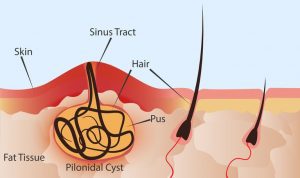Pilonidal Cyst Surgery Recovery
What is a pilonidal cyst?
A pilonidal cyst is a sac that develops at the base of your tailbone and is packed with hair and skin debris. Formerly believed to be a congenital disorder (produced in utero), researchers now believe they are acquired through inward-growing hair from nearby soft tissue and skin that results in a foreign body reaction and thicker tissue.
Most commonly, they occur in men in their 20s and 30s and are 2.2 times more common among men than women. Warm compresses, sitz baths, and antibiotics are some of the common treatments to start. But if the infection is serious, surgery might be necessary.
Can pilonidal cysts be surgically removed or incised and drained?
About 60% of the time, an incision and drainage surgery works to treat a pilonidal cyst. Doctors usually decide to perform an incision and drainage procedure as pilonidal cyst removal surgery if the condition is not severe, or if you are the first time receiving the treatment. Doctors frequently advise patients who have the treatment to try to prevent further infection by getting hair removal including shaving, waxing, or laser hair removal.
Doctors might advise surgical cyst removal if you’ve already undergone an operation for incision and drainage, your cyst has returned, the infection is bad, or you also have several cysts with sinus tracts.
Potential risks of Pilonidal Cyst Surgery
Incision and drainage are the most common treatment options for pilonidal cysts, which rarely result in major complications. Pain is the most common complication among trusted sources. Surgery to remove a pilonidal cyst typically results in scarring. Over time, the scar will be less visible.
Pilonidal cyst surgery can result in infection after incision, drainage, and surgical excision. Tenderness, oozing pus, redness, chills, and fever are all infection warning signs. The following potential complications are also possible: seroma (fluid buildup), hematomas (bruises), or poor recovery. Pilonidal cysts are at risk of recurrence after the procedure. There might be more than one operation required to remove a pilonidal cyst.
How long is the recovery time from pilonidal surgery?
The recovery time from pilonidal cyst removal will depend on how the procedure goes. To fully recover, it will most likely take around four weeks for the cut (incision) to fully heal if sutures are used to close the incision. However, it could take many weeks to several months for your incision to heal if the surgeon decides to leave it open. You will have a scar where the cyst was removed once the incision has healed. With time, this will dwindle and get softer.
After two to four weeks, most people can return to work and perform most activities. We recommend you avoid doing intense exercise and occupations that demand prolonged sitting until your injury is fully recovered.
You can get a rough estimate of how long it will take you to recover from this surgery from the information below. However, everyone experiences a different timeframe in terms of recovery.
To get better as soon as possible, adhere to the steps below.
Daily Activities
- Take as much rest as you need. Your scar recovers sooner while you have enough rest.
- Try to take a daily short stroll. Start with taking a few extra steps today than yesterday. Walking increases blood flow, which reduces the risk of constipation and pneumonia.
- When you finish the shower, use a clean cloth to pat the area surrounding your incision dry. Till the wound is healed, avoid taking baths. Keep the space clean and dry.
- Your doctor will advise you on when you can resume driving.
- Until your incision is healed, avoid sitting for extended periods or on hard surfaces.
- Most patients can resume their jobs two to four weeks after surgery. Each patient is slightly different in recovery time.
Diet
- Most patients don’t need to change too much of their diet post-surgery. Try low-fat and light food such as plain rice, grilled chicken, bread, and yogurt if your stomach is disturbed.
- Drink a lot of water (unless your doctor tells you not to).
- After the surgery, it’s not uncommon to notice that your bowel movements are unusual from your normal. You might wish to take a daily fiber supplement to prevent constipation or bowel movement difficulty. Ask your doctor about mild laxatives if you haven’t had a bowel movement for more than three days.
Medication
- Your doctor will let you know whether you can take your usual medications or not. In addition, your doctor will give directions for taking any new medications.
- Ask your doctor if and when you should resume taking any blood thinners you are currently taking, such as aspirin.
- Follow the directions for the medication on your prescription.
After surgery care
- The cost of pilonidal cyst surgery in the USA can vary widely depending on several factors, including the location of the surgery, the specific surgical technique used, the surgeon’s experience, and whether the procedure is performed in an outpatient clinic or a hospital. It’s essential for patients to consult with their healthcare providers and insurance companies to get a more accurate estimate of the pilonidal cyst surgery cost in USA.
Pilonidal cyst surgery cost in USA
- Clean the stitches area every day with warm, soapy water before patting it dry. Avoid using alcohol and hydrogen peroxide, they can impede healing. If the area weeps or scrapes against clothing, you should cover it with clean gauze. Remember to change it every day to keep the scar.
- If your incision was left open to heal, follow your doctor’s instructions for changing the bandage, also known as a dressing. Changing dressing can be painful at first. It may be a good idea to take a pain reliever 30 minutes before changing the dressing. Try soaking the dressing in warm water for about 10 minutes before removing it if it clings to your wound. You can do this in the shower or by covering the dressing with a wet cloth. You might notice a greenish-gray fluid coming from your wound. It shows that the cut is recovering.
Additional directives
- If you have trouble sitting, use a doughnut cushion. Find out from your doctor which hair removal technique is most effective since you want to keep hair away from the area around your wound.




